I would like to introduce in this post the main problems we have detected in the Selection implementation of two of the most important web engines, such as Blink and WebKit. I’ve already described some of these issues, particularly for CSSRegions, but I’ll go a bit further now analyzing them and also introducing one of the proposal we have been working on at Igalia s part of the collaboration we have with Adobe.
Selection is a DOM Tree matter
At Igalia, we have been investigating how to adapt the selection to the new layout models which provide more complex ways of visualizing the content defined in the DOM Tree. Let’s consider the following basic example using CSSRegions layout:
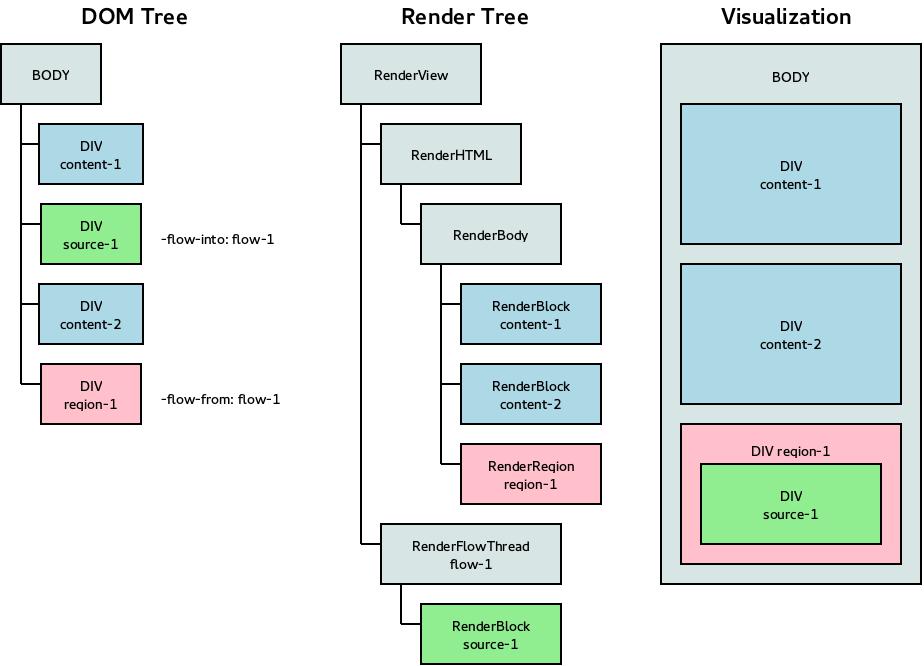
In the last post about this issue we have identified 4 main problems with selection in CSSRegions:
- Selection direction
- Highlighting and content mismatch
- Incorrect block gaps filling
- Clear the selection
I’ll describe some examples where these issues are present, where are the root causes and how they can be solved or, at least, improved. I’ll try as well to explain how the Selection works, starting from the mouse events the end user generates to perform a new selection, how those are mapped into a DOM Tree range and finally, how the rendering process produces the highlighting of the selected elements.
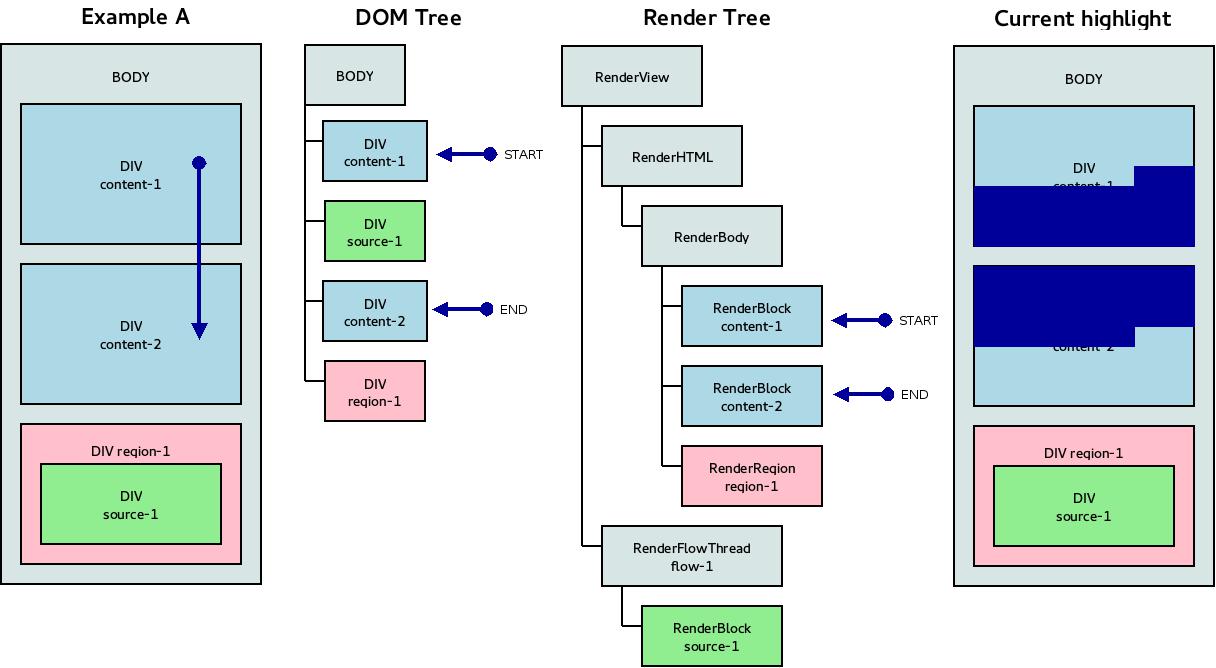
I’ll use this first example (Figure 2) to briefly describe how the Selection is implemented and how all the involved components interact to generate both, the selected DOM Range and the corresponding highlighting by the RenderTree. Obviously the end user selects contents from the Visualized elements, in this case the content of two regular blocks (no regions involved). The mouse events are translated to VisiblePosition instances (Start and End) in the DOM Tree using the positionForPoint method. Such VisiblePositions are then mapped into the corresponding RenderObjects in the Render Tree; these objects are the ones used to traverse the tree in the RenderView::setSelection method and mark the appropriated elements with one of the following flags: SelectionNone, SelectionStart, SelectionInside, SelectionEnd, SelectionBoth. These flags are also very important in the block gaps filling algorithm, implemented basically in the RenderBlock::selectionGaps method.
The algorithm implemented in the RenderVieww::setSelection method can be described, very simplified, as the following steps:
- gathering information (RenderSelectionInfo and RenderblockSelectionInfo) of the old selection.
- clearing the old selection (basically mark all the elements as SelectionNone)
- updating the flags of the elements of the new selection.
- gathering information of the new selection.
- repainting old objects which might have changed.
- painting the new selected objects.
- repainting the old blocks which might have changed.
- painting the new selected blocks.
The algorithm traverses the RenderTree, from the Start to the End using the RenderObject::nextInPreOrder function. Here is where the clear operation issues can appear. If not all objects can be reached by the pre-order traversal, the clear operation does not work properly. That’s why we introduced a way to traverse back the Tree (r155058) looking for elements which can be unreachable. One of the causes of this issue is the selection direction change.
This first example shows the highlighting and content mismatch issue, since the DOM Range considers the source (flow-into) element, while is not highlighted by the RenderTree.
The next example considers now selection from both regions and regular blocks and introduces also an interesting Selection topic: selection direction.
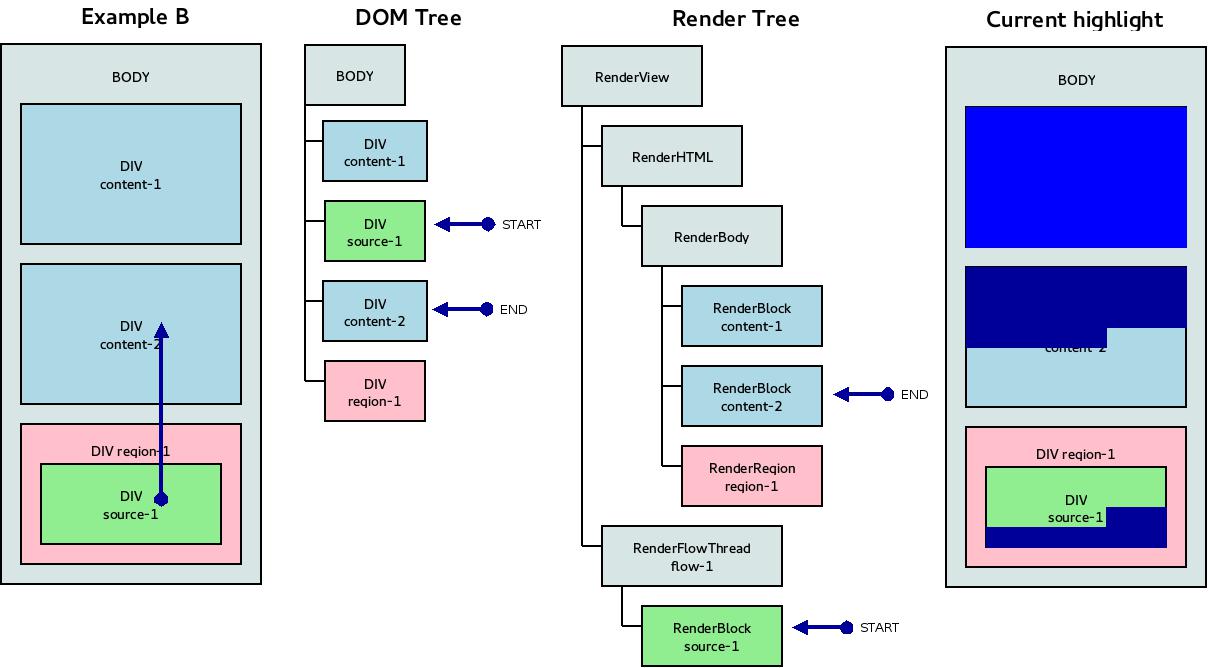
As you can see in the diagram Figure 3, the user selected content upwards. In most of the cases the selection direction is not used at all, so Start must be always above the End VisiblePosition in the DOM Tree. The VisibleSelection ensures that, but in this case, because of how the Source (flow-into) is defined according to the CSSRegions specification and where it was placed in the HTML code, the original Start and End position are not flipped. We will talk more about this in the next example. However, the RenderObject associated to a DOM element with a flow-into property is located in the in the render tree under the RenderFlowThread object, which itself is placed at the end of normal render tree, thus causing the start render object to be below the end render object. This fact causes the highlighted content to be exactly the opposite to what the user actually selected.
This example illustrates also the issue of incorrect block gaps filling, since the element with the id content-1 is considered a block gap to be filled. This happens because of the changes introduced in the already mentioned revision r155058 since the element with id content-2 and the body are flagged as SelectionEnd, the intermediate elements are considered as block gaps to be filled.
At this point is quite clear that the way the Render Tree is traversed is very important to produce a coherent selection rendering; notice that in this case, highlight and selected content match perfectly. The idea of using the Region DIV as container of the Source DIV content portion, which is rendered inside such region, looks like a promising approach. The next example will go further into this idea.

In this example (Figure 4) the Start and End VisiblePosition instance have to be flipped by the generated VisibleSelection, since the DIV with the id content-1 is above the original Start element defined by the end user. By flipping both positions it makes the corresponding Start and End RenderObject instances to be consistent, that’s why there is no selection direction issue in this case. However, because of the position of the End element as child of the RenderFlowThread, the RenderElement with the id content-2 is selected, which, while being seamless from the user experience point of view, it does not match the selected content retrieved from the DOM Range.
The solution: Regions as containers
At this point is clear that the selection direction issues are one of the most important source of problems for the Selection with CSSRegions. The current algprithms, RenderView::setselection and RenderBlock::selectionGaps, require to traverse the RenderTree downwards from start to end. In fact, this is specially important for the block gaps filling algorithm.
It’s important to notice that the divergence of the DOM and Render trees when using CSSRegions comes from how these two concepts, the flow-into DOM element and the RenderFlowThread object, are managed and placed in each trees. Why not just using the region elements for the selection algorithms and considering both flow-into and RFT as “meta-elements” where the selected content is extracted from ?
Considering the steps defined previously for the selection algorithm the regions as containers approach could be described as follows:
- Case 1: Start and Stop elements, either both or none, are children of the RenderFlowThread.
- The current RenderView::setSelection algorithm works fine.
- Case 2: Only Start is child of the RenderFlowThread.
- First, determining the RenderElements range [RegionStart, RegionEnd] in the RenderFlowThread associated to the RenderRegion the Start element is rendered by.
- Then, applying the current algorithm to the range of elements [Start, RegionEnd]
- Finally, applying the current algorithm from the NextInPreOrder element of the RenderRegion until the Stop, as usual.
- Case 3: Only Stop is child of the RenderFlowThread.
- First, applying the current algorithm from the Start element to the RenderRegion the Stop element is rendered by.
- Then, determining the RenderElements range [RegionStart, RegionEnd] in the RenderFlowThread associated to the RenderRegion the Stop element is rendered by.
- Finally, applying the current algorithm to the range of elements [RegionStart, Stop]
Determining the selection direction, at VisibleSelection, is also affected by the structure of the RenderTree; even that the editing module in both WebKit and Blink is also using rendering info for certain operations, this is perhaps one of the weakest points of this approach. Let’s use one of the examples defined before to illustrate this situation.
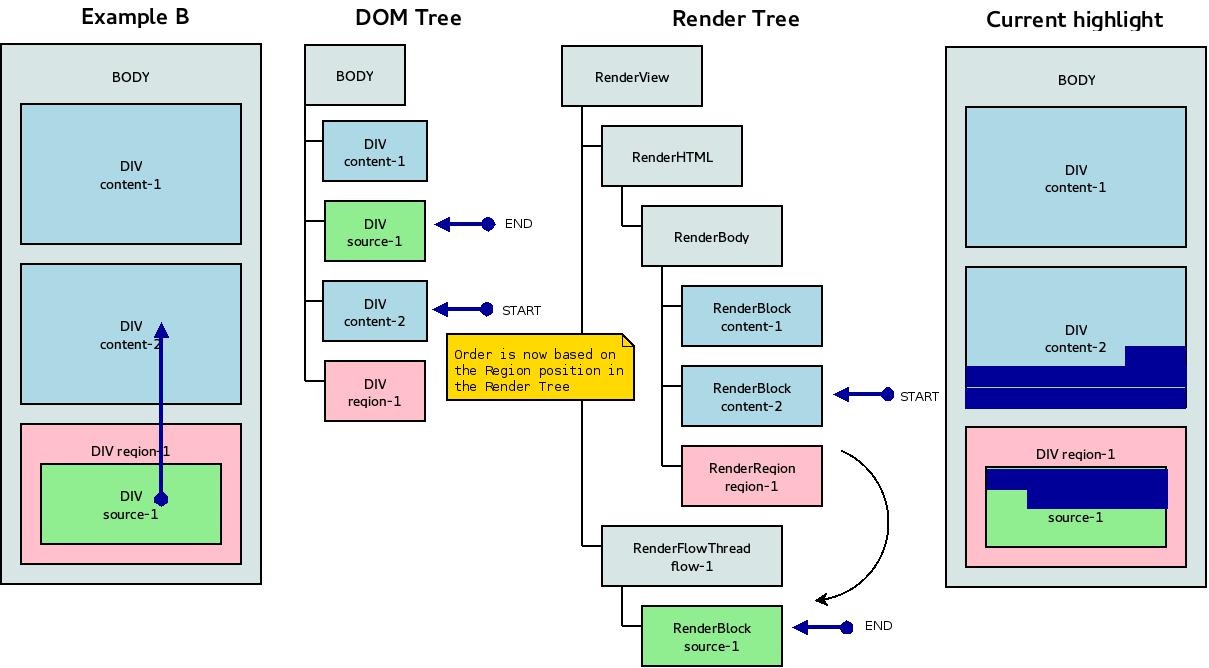
While traversing the RenderTree, once a RenderRegion is reached its corresponding range of RenderObjects is determined in the RenderFlowThread. The entire range will be traversed for the blocks flagged as SelectionInside. For the ones flagged as SelectionStart or SelectionEnd, the steps previously defined are applied.
The key of this new approach is that traversing is always downwards, from the Start to the End, which solves also the block gaps related issues.
Let’s considering now a more complex example (Figure 6), with several regions between a number of regular blocks. selection is more natural with this approach, coherent with what the user expects and also matching the DOM Tree range for most of the cases. This is, however, the biggest drawback of this approach, since it does not follow completely the Editing/Selection specs. I’ll talk more about this in the last lines of this post.
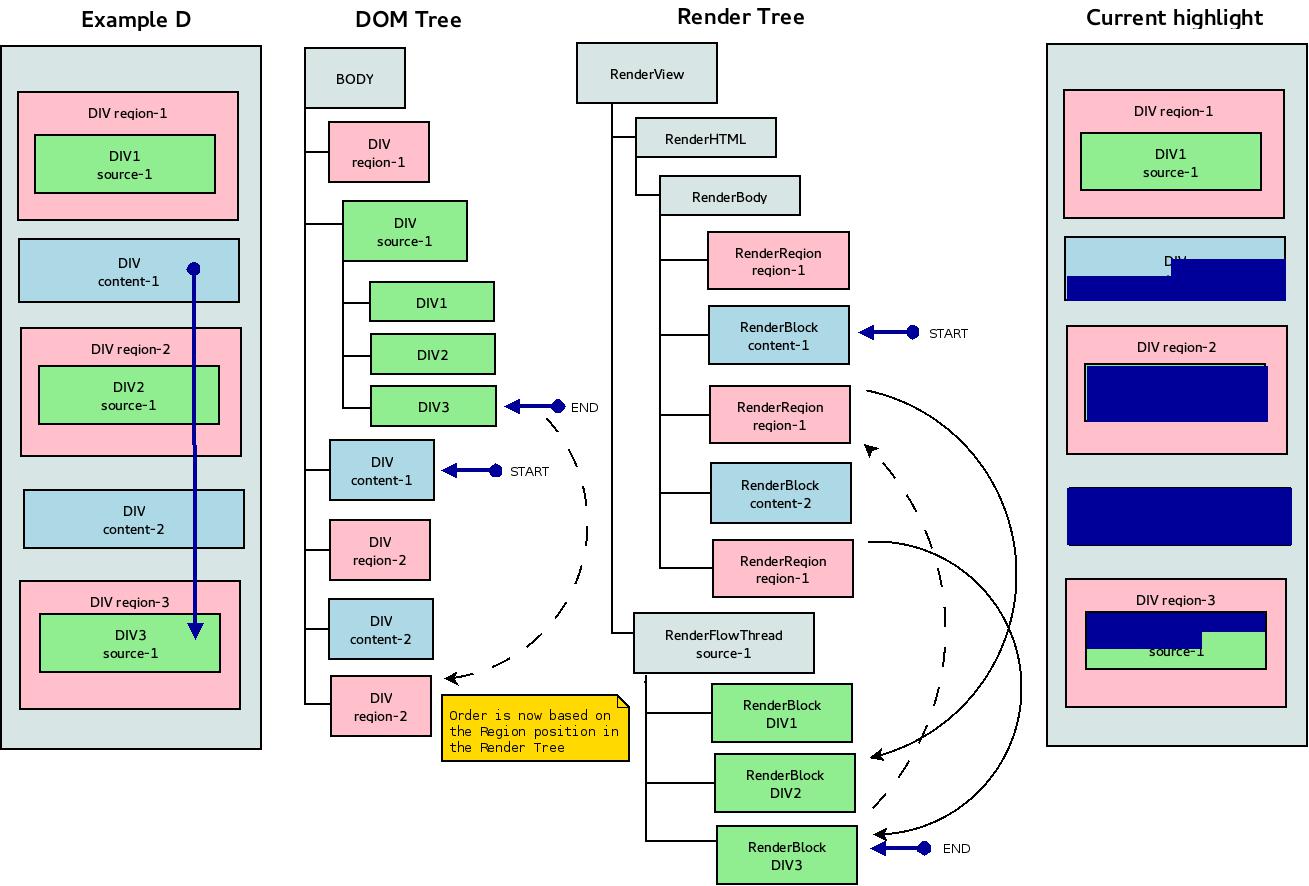
The following video showcase our proposal on the WebKit MiniBrowser testing application using a real HTML example based on the Figure 6 diagram.
Even though selection is more natural an coherent, as I already mentioned, it does not follow completely the Editing/Selection specs. As I stated at the beginning of this post, selection is a DOM matter, defined by a Range of elements in the DOM Tree. This very simple case (Figure 7) is enough to describe this issue:

The regions as containers approach does not considers the Source (flow-into) elements as actual DOM elements, so they will never be part of the selection. This breaks the Editing/Selection specification, since those are regular DOM elements as they are defined in the CSS Region standard. This approach was our first try and perhaps too ambitious, providing a good user experience on selection with CSSRegions and specs compliant at the same time. Even that it was a good experience we can conclude that the problem is too complex and it requires a different strategy.
We had the opportunity to introduce and discuss our proposal during the last WebKitGtk+ Hackfest, where Rego, Mihnea and me had the chance to work hand in hand, carefully analyzing and digesting this proposal. Even that we finally discard it, we were able to design other approaches which some of them are really promising. Rego will introduce some of them shortly in a blog post. Hence, can’t end this post without thanking to Igalia and the GNOME Foundation for sponsoring such a productive and useful hackfest.